I’m in an artist’s group that meets every Friday afternoon to paint with watercolors or sketch. We meet in a different location every week, outdoors in good weather, often in a beautiful garden or a farm. The group of 15-20 people range from beginning artists and dabblers to some of South Whidbey’s most accomplished professional artists. We usually wander throughout the venue first, exploring what pulls our interest, taking in what we might spend an afternoon trying to re-imagine onto art paper. It is easier to get a focus some days than others, sometimes never find one, or, as is most often the case, be overwhelmed by too much inspiration.
Artists’ eyes tend to see everything, the shades of colors and shapes and details that may go unnoticed by those not trained to see as an artist sees. And the longer you look at something, the more you see and want to paint—everything! During a recent afternoon in a lovely seaside garden, one artist was halfway through her painting when she loudly proclaimed her frustration: “There are too many leaves in the world!”
Something similar happened to me in preparing this sermon. As in painting a picture on a Friday afternoon, there are just too many wonderful themes in today’s scripture lessons, too much material to explore to try to get down on paper.
The sermon I was going to ‘paint’ focused on the first lesson from Ecclesiastes and how it connects to the parable in the gospel lesson. I had planned to point out the obvious—that these lessons, by themselves, without the following sections we didn’t read, could leave us with a despairing feeling. Like “Vanity of Vanities… all is vanity.” How often do we think of the phrase “eat, drink, and be merry” without also concluding with “for tomorrow you may die”? I had planned to tell you about the origins of that phrase, and how differently we hear “eat, drink, and be merry” depending on where we are in life. I was going to tell you how the rich farmer’s hoarding was probably an indication of his insecurity and fear of not having enough. And I planned to expound on why God called the rich farmer a “Fool” and what it might mean to be rich toward God. It was going to be a very erudite sermon, and you would have been so impressed.
That’s the sermon I was planning to preach. Barbara Wihlborg, who puts together the service leaflets for us, asked me a couple of weeks ago what I would like to have on the cover. I was still wandering through the assigned scriptures for today, trying to get a focus on what sermon picture I wanted to try to paint for you in a sermon, and I thought of a sermon I’d already painted! Literally! Preachers are often accused of recycling old sermons—we call them “retreads.” But this is not a word sermon, but is literally a picture sermon—the icon on the service leaflet cover, which relates to the epistle reading.
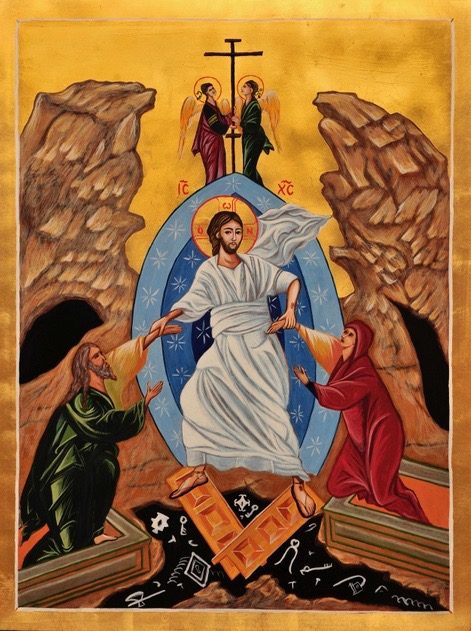
So I sent Barbara the file of the icon, thinking it would wind up in less noticeable black and white on the cover, and I could keep my options open for the direction I’d take in the sermon. But Barbara emailed me this week that she was so taken with the icon that she had printed all of the bulletins in color. Seeing this icon in color is necessary for interpreting it, and since Barbara spent a lot of color ink so you could properly see it, I have to use this one
opportunity to tell you about it. All that’s more than you probably want to know about how sermons and service leaflets get produced.
I painted, or wrote, this icon in 2009, and it is one of two icons I painted for St. Mark’s Episcopal Church in Houston, where it is permanently installed in the narthex.
Icons tell a story through the symbolic language of image. Icons are like a puzzle that engages you and you have to figure out, and when you are engaged in figuring out an icon, you are actually praying— paying attention to the divine images of the icon. When I use this icon in a retreat setting, I ask people to spend time just looking at it and wondering who the people are and what is going on. Since time does not allow for a leisurely look today, I’ll tell you the main points, and hope you’ll spend more time later.
So, looking at this icon, let us pray. This icon is called Anastasis, which is Greek for "Resurrection." The Risen Christ is the figure in the center, and you can tell this is the Risen Christ by several symbols. What’s the color we use for Easter? White. Perhaps you can see the nail scars in his feet and wrists, indicating this is after the Crucifixion. He is surrounded by a full-body halo called a mandorla, which represents the traditional concept of a three-story universe.
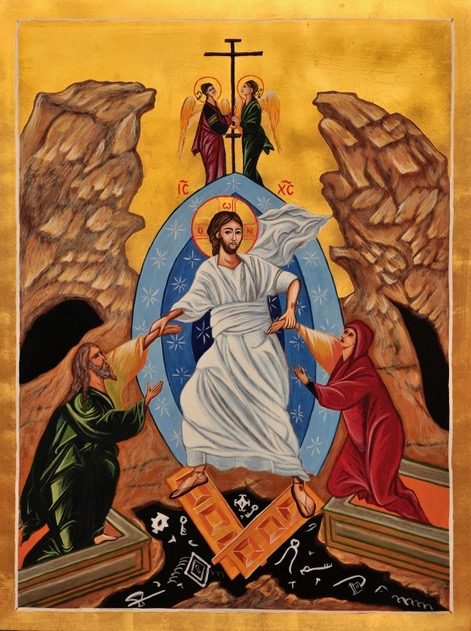
He has broken through the hard rock of the earth and descended into hell, or Hades, the place of the dead—hence the two other names for this icon: “The Harrowing of Hell” or “The Descent into Hades.” The opposite of anastasis is descent: katabasis. Anastasis, up; katabasis, down. You can tell he has descended because there’s an obvious updraft—his mantle has flown up behind him. He is standing on the gates of hell he has just smashed open. Below the broken gates in the black pit are instruments of torture of hell.
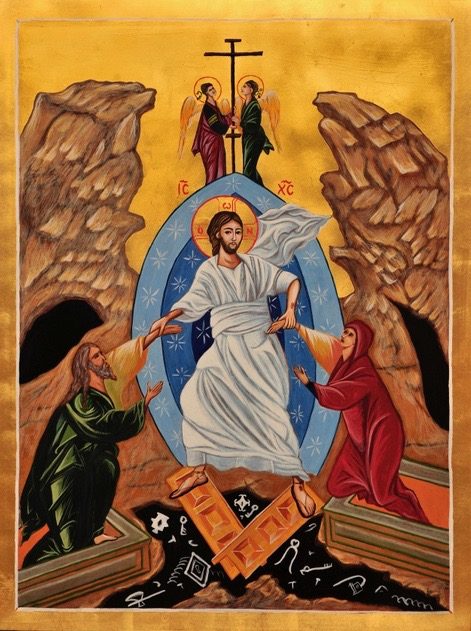
If we had time, you could figure out who the man and woman are right next to Christ. These are archetypal figures that go back to the very beginning of humankind: Adam and Eve. What is Christ doing with them? Look at his hands and Adam and Eve’s hands. Is he shaking their hands as in a reciprocal meeting? No! He has grasped them by the wrist, and is pulling them out of their graves. With sleeves rolled up like anyone who is doing some heavy lifting, Christ is hauling Adam and Eve out of their deadness.
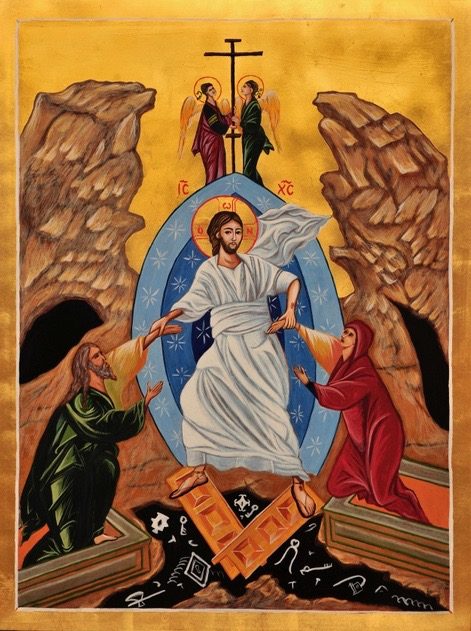
In the Eastern Orthodox Church (where this icon originated) this is the icon for Holy Saturday, the day before Easter. For Christians in the West, the Crucified Christ is presumably lying dead in the grave on Holy Saturday, which we tend to observe by dyeing Easter eggs. But for Orthodox Christians, Holy Saturday is when Resurrection happens. This icon shows The Lord of the Sabbath working on Saturday, the traditional Hebrew Sabbath. Scripture says: “the gospel was proclaimed even to the dead,” that “Christ was put to death in the flesh, but made alive in the spirit, in which also he went and made a proclamation to the spirits in prison” (I Peter 4:6; 3:18). Hell or Hades, the place of the dead—that’s where all the Resurrection action takes place.
How’s that for a major theological point? The Risen Christ has broken open the gates of hell and raided hell of its imprisoned occupants.
Notice now the two angels at the top holding the cross. Genesis tells us that, after sending Adam and Eve into exile, God stationed angels at the entrance to the Garden of Eden with a flaming sword that turned in all directions to prevent anyone from gaining access to the tree of life. But the two angels in the icon bear instead the cross, the way, not of obstruction to Paradise, but of access to eternal life.
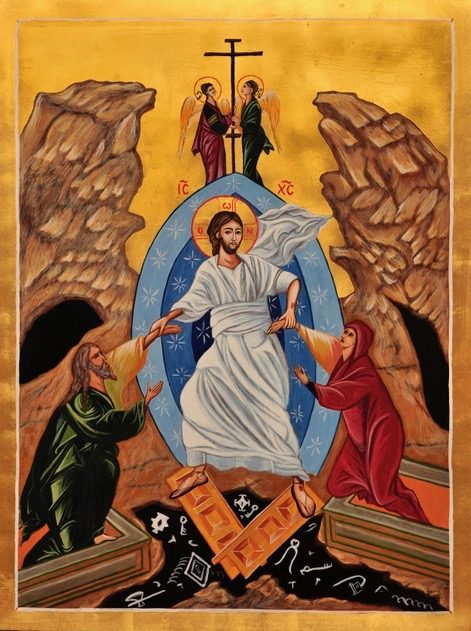
I want to point to one more important detail. And this may be the most important of all: Notice the color of Adam and Eve’s sleeves. The parts of them closest to the Risen Christ have already begun to change. Adam and Eve are already beginning to be transformed. They’re not even completely out of their graves yet, but they’re beginning to change in the parts of themselves closest to Christ. I wonder: just who is being resurrected in this icon? What do you think?
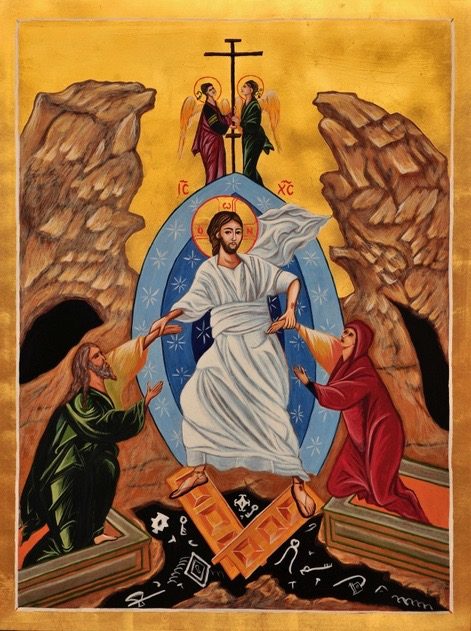
The epistle today begins: “So if you have been raised with Christ….” God has given each of us the opportunity to live into the resurrected life, to be fully alive in Christ. This process of transformation is not a do-it-yourself project; rather, it is a cooperative process. The Risen Christ does the heavy lifting of waking us up and pulling us up out of out deadness, but at some point we have stand up. We have to participate, to actively cooperate, to consciously work together with Christ. And today’s reading from Colossians tells us how to begin to do this: “So if you have been raised with Christ, seek the things that are above . . . and set your minds on things that are above . . . for you have died, and your life is hidden with God in Christ” (Colossians 3:1, 2, 3).
Maybe this afternoon or sometime later this week, I hope you’ll take another look at the Resurrection icon on the cover, then take another look at today’s reading from Colossians.